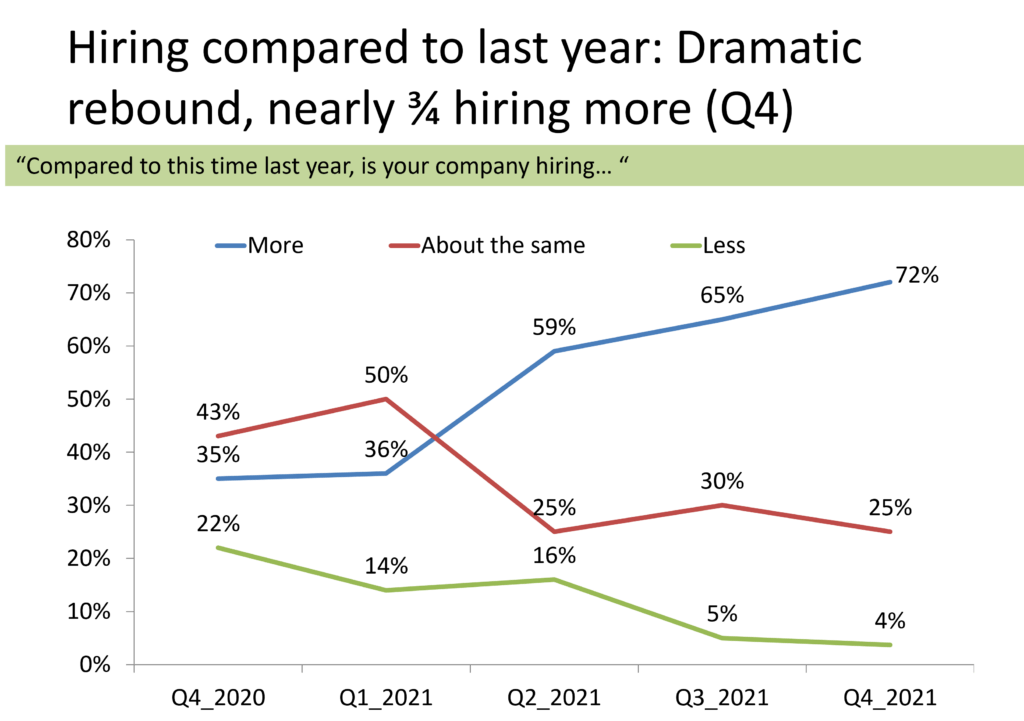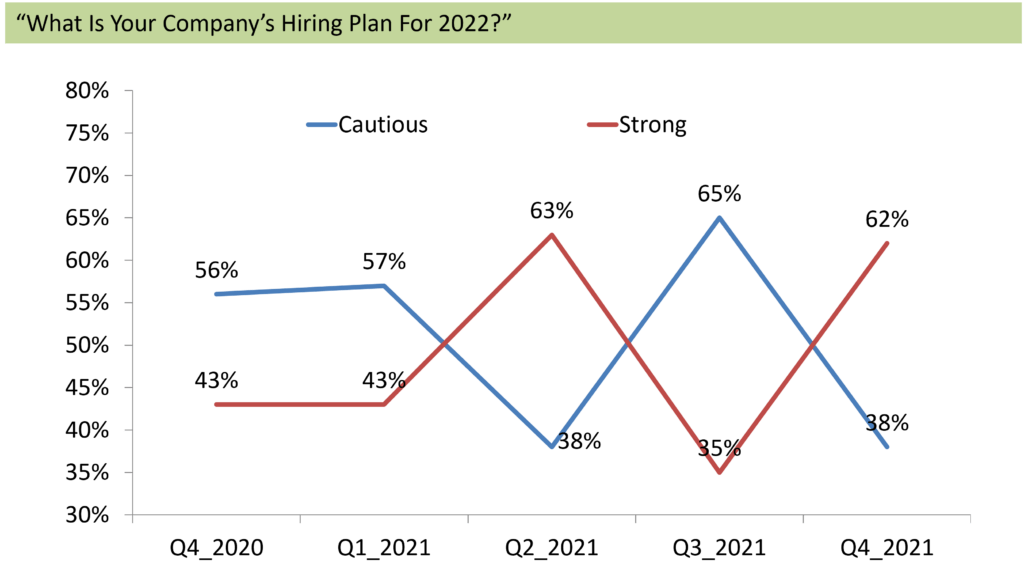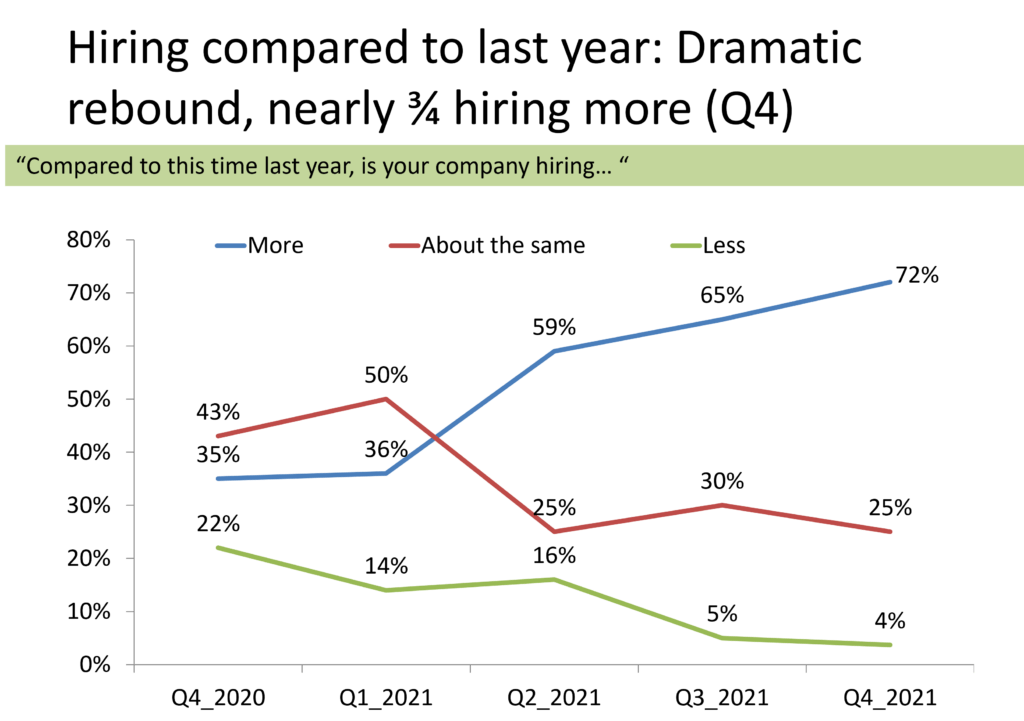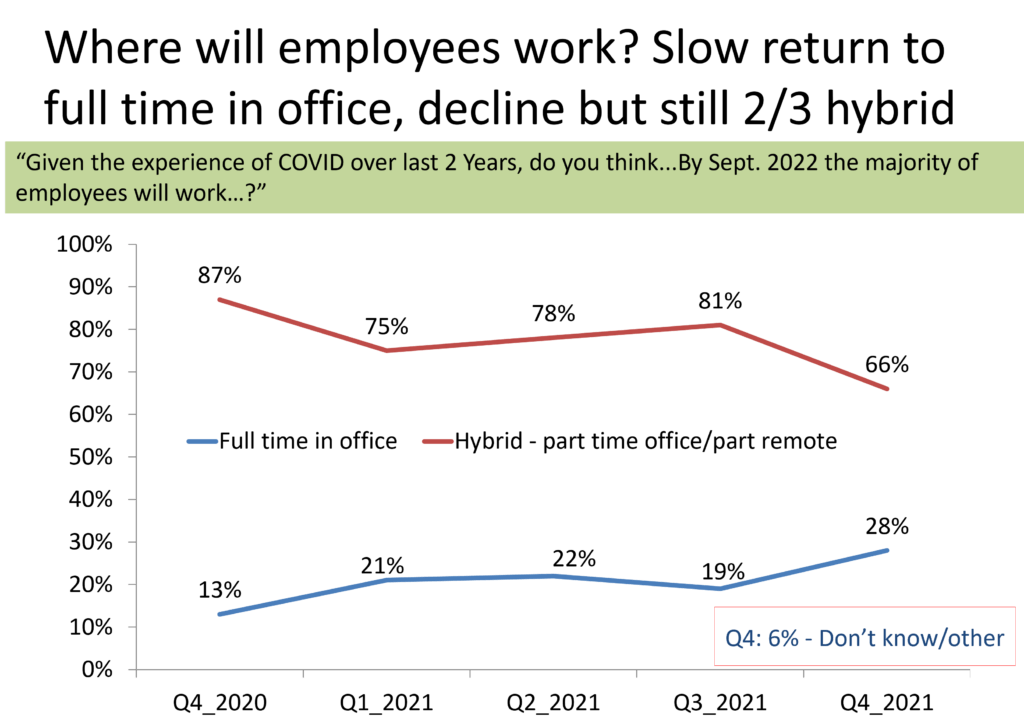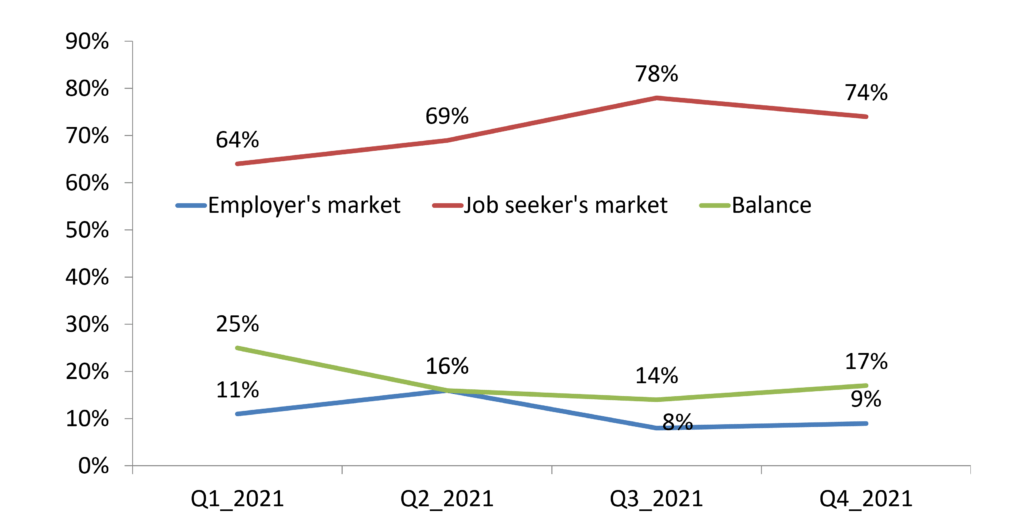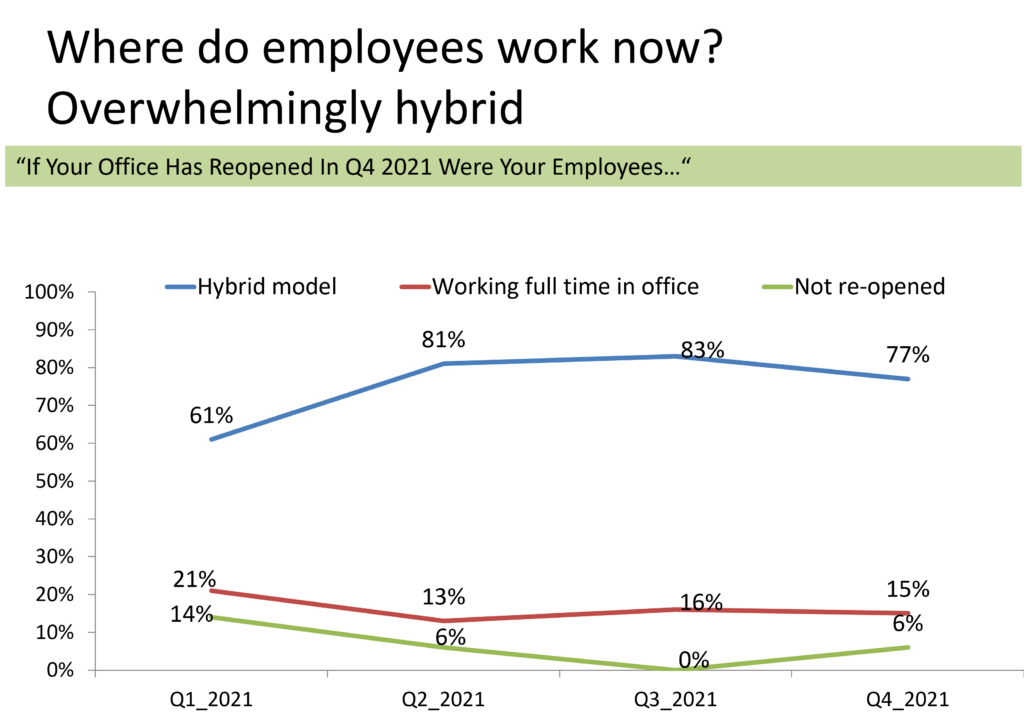Israeli high-tech startups plan hiring spree in 2022 as pandemic recedes
Battle for software/R&D staff intensifies amid shortage of qualified candidates
- As pandemic fears decline, startup recruitment plans rebound in sharp reversal from Q3 2021
- Job-seeker’s market continues as majority of startups increase recruitment in Q4 2021 and make plans to hire more employees in 2022
- Majority of startups report widespread shortage of qualified candidates with software/R&D staff most in demand
- Hybrid work patterns continue, but may harm productivity for some companies
- “We’re now growing almost 100%, across R&D, operations and sales.” – Dror Talisman, CEO of NeuroBrave Ltd
- “It’s harder to find people with certain specific expertise. The ‘fight’ over highly qualified hires has increased in Q4 over Q3. In multiple cases we had to raise salaries to fight and get the employee on board.” – CEO, Israeli high-tech startup
- PLEASE NOTE: This report was compiled before the Russian invasion of Ukraine
The OurCrowd High-Tech Jobs Index is a quarterly report and data series tracking vacancies and hiring patterns at high-tech companies in Israel and abroad. All data is based on a survey and the Portfolio Jobs section of the OurCrowd website, where more than 150 portfolio companies list current vacancies (Q4 2021 edition, published March 2022).
EXECUTIVE SUMMARY
Hiring rebounds in Q4 2021 with strong outlook for 2022
Israeli startups are expanding. 72% of portfolio companies report hiring more staff in Q4 2021 compared to the same period the previous year – double the figure of 36% in Q1 2021.
Startups expect the post-pandemic hiring spree to pick up pace in 2022. The expectation of most companies in Q3 that recruitment would slow in 2022 dissolved in Q4 with the decline of the global crisis triggered by the Delta variant of Covid-19. 62% of those surveyed in Q4 say they have strong hiring plans for 2022, a sharp increase from Q3, when only 35 percent of portfolio companies planned strong hiring for the next year. Our Q3 2021 survey covered July, August and September – the peak of the Delta wave.
“We’re now growing almost 100%, across R&D, operations and sales,” says Dror Talisman, CEO of NeuroBrave Ltd.
Job-seeker’s market: Severe shortage of qualified candidates
By a margin of more than two to one, companies say they cannot find enough qualified applicants for open positions. Three-quarters of portfolio companies say the job-seeker’s market, apparent in our surveys for the past year, continued into Q4 2021 and is likely to persist in 2022.
64% of the companies surveyed have some employees located abroad, while 36% are located entirely in Israel. Four fifths (79%) of those offering jobs outside Israel said the foreign positions amounted to 25% or less of the available openings in Q4 2021.
Demand for software/R&D staff: Few candidates, stiff competition
Three quarters of portfolio companies report that in Israel, they are hiring for software/R&D departments and 79% say that these positions are the most difficult to fill.
“It’s harder to find people with certain specific expertise. The ‘fight’ over highly qualified hires has increased in Q4 over Q3. In multiple cases we had to raise salaries to fight and get the employee on board,” says one CEO.
Only 9% of companies say their companies are hiring for operations, HR, product development and product management positions. When asked which positions are the hardest to fill, only 9% cite sales and business development and hardly any report difficulty filling product management, operations, or marketing.
Hybrid/remote work continues for large majority of companies in Q4
More than three quarters (77%) of companies were still engaged in hybrid working in Q4 2021 – a small decline from the peak of 83% in Q3. For all of 2021, on average 76 percent of companies reported employees working hybrid and 16 percent on average reported employees working full time in the office.
Throughout the year, hardly any respondents reported that their employees work remotely full-time. Just three of the 53 companies participating in our Q4 survey had not re-opened their workplace at all.
Hybrid working set to continue in 2022, but minority will return to office
A large two-thirds majority anticipate the hybrid working model will continue into 2022 – declining from 81% percent in Q3 who expected hybrid work to continue. Just over one quarter (28%) expect their employees will be working full time in the office by next September.
One third of companies say hybrid working reduces productivity
A 40% plurality say the increase in remote and hybrid working had no impact on employees’ levels of productivity. But one-third of respondents (34%) say that the lack of full-time office working reduced productivity, while 27 percent say it had a positive effect.
“Older employees become more attractive, as they are more disciplined about working remotely,” says Tal Bakish, CEO of VocalZoom.
Minimal gains for periphery hiring due to pandemic
A 55% majority of respondents say that their pattern of hiring from the center or periphery of Israel did not change in Q4. 26% reported increased hiring from the periphery while 19% say they hired fewer people from the periphery.
When asked directly whether the increased experience with remote work over the pandemic caused them to recruit more people from the periphery, 25% say it did, but 62% say it had no impact.
The OurCrowd Jobs Index was prepared under the guidance of Dr. Dahlia Scheindlin of Independent Opinion Research & Strategy, who helped re-design the survey and analyzed the findings.

Job openings in Our Crowd portfolio companies, 2021
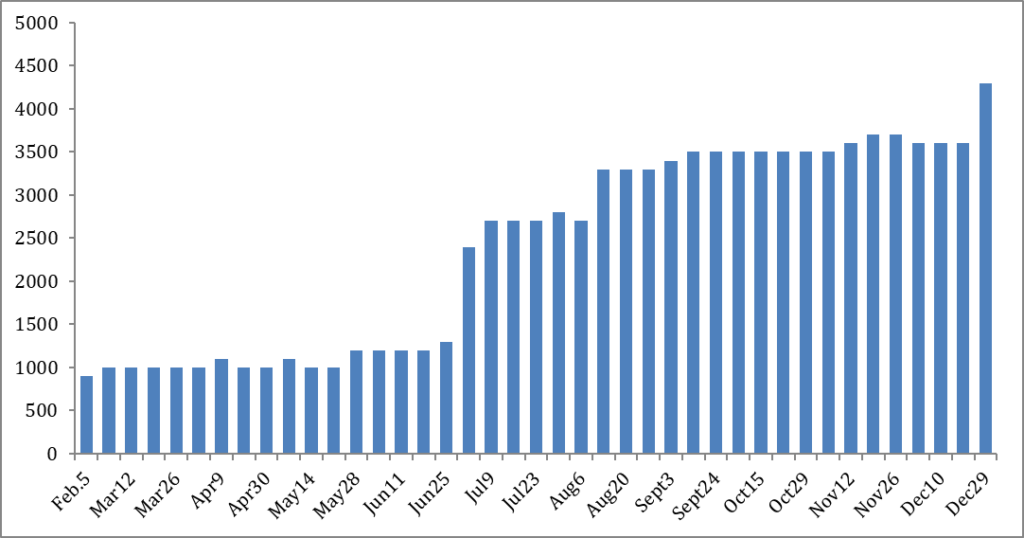
From the start of reporting on February 5, through the last reported day of 2021, December 29, the absolute number of open positions advertised by portfolio companies increased nearly five-fold, from 900 positions to 4,300 open positions. (The number of companies reporting also increased, but exact figures are not available).
SURVEY FINDINGS Q4 2021
Survey of portfolio companies, conducted Feb 2022, N=53.
1. Companies’ hiring plans for 2022
What is your company’s hiring plan for 2022?
Companies indicate robust hiring trends for the coming year, with a majority of 62% who say they are planning strong hiring in 2022. Over the last year, the companies’ hiring plans for the future have been erratic: as recently as Q3 2021, nearly two-thirds (65%) reported cautious hiring plans for 2022, but that figure dropped to just 38% in Q4. In Q3 only 35% reported strong hiring plans, and this figure rose 27 points in Q4. The current finding is closer to Q2 reporting (when 63% were planning strong hiring for the coming year). Note that the Delta wave of Covid hit Israel in August and September, and may have caused uncertainty regarding future hiring.
2. Companies’ hiring patterns in Q4 2021
Given the experience of Covid developments over the last two years Compared to this time last year, is your company hiring:
72% of portfolio companies report hiring more in Q4 2021 compared to the same period the previous year. This proportion doubled compared to the Q4 2020 survey, when just 35% reported more hiring compared to the previous year.
3. Remote vs. On-site work
Do you think that by September 2022 the majority of your employees will work:
In Q4 2021 companies reported the most significant decline of the year in predicted hybrid home-office work models for the next year, and a corresponding rise in the portion of companies whose employees are expected to work full time in the office by September 2022.
But a large two-thirds majority still anticipate a hybrid working model (66%). This is a decline from 81% in Q3 and 87% in Q4 of 2020.
Just over one-quarter (28%) report that their employees will be working full time in the office by September.
4. Market for job seekers or employers?
Based on the hiring needs of your company and the quantity/quality of candidates that you are seeing, is the current job market in your opinion:
Fully three-quarters of portfolio companies view the hiring scene as a job seeker’s market, very similar to Q3 results. Fewer than one-fifth (17%) believe the hiring market is balanced and just 9% say it is an employer’s market.
5. Availability of qualified candidates
“Over the last quarter of 2021, which is the best description of your company’s employment/HR situation?”
More than twice as many companies report that they have not had enough qualified candidates applying for their open jobs (62%), than those who report that there are a sufficient though not high number of qualified candidates (30%). Just a few respondents (6%) stated that they encountered more qualified applicants than open positions.
6. Main hiring sectors
“Which departments are you hiring for in Israel?”
Software/R&D outstrips all other departments, with three-quarters of respondents who reported that their companies are hiring for these departments. Other departments represent a distant second, with less than 10% who reported that their companies are hiring for operations, HR, and product management.
7. Competition for employees
“Which positions do you find have been the hardest to fill in Israel in the last quarter of 2021?”
Overwhelmingly, companies report difficulty filling software and R&D jobs, indicating high competition and a shortage of candidates with the appropriate skills.
8. Willingness to employ from the periphery
“Over the last quarter of 2021, which response best describes the change in the number of employees hired from Israel’s “periphery,” rather than from the center?”
and
“Over the last two years, many companies adopted remote work models. Did the increase in remote work options in high tech affect your hiring of employees from the periphery?”
A majority of respondents, 55%, said that their pattern of hiring from the center or periphery of the country had not changed following the developments of the last two years. Nearly one-fifth (19%) said they had hired fewer people from the periphery, and just over one-quarter (26%) reported increased hiring from the periphery.
When asked directly whether the increased experience with remote work over the pandemic caused them to recruit more people from the periphery, one-quarter (25%) responded that they had in fact hired more people from the periphery as a result of the experience with remote work. A majority, 62%, said the increase in remote work did not have any impact on their level of hiring from the periphery.
9. Employment – in Israel or abroad
“Are all your employees based in Israel?”
Just over one-third said that all their employees are based in Israel, while a clear majority of companies, 64%, responded that this is not the case – indicating that they employ people abroad as well.
10. Location of employment opportunities
“What % of your current job openings are located abroad?”
A large majority of 79% reported that up to 25% of their job openings are located abroad – therefore, the remainder of their jobs are located in Israel. Just 21% in total said that half or more open positions are located abroad.
11. Pandemic impact on sales operations abroad
“During the last 2 years of COVID, many companies found that B2B deals abroad can be sourced and closed from one location (without requiring travel), over Zoom. As a result of the last two years, has your company changed policy regarding sales teams abroad in any of the following ways…”
About one-fifth of respondents reported that their companies have reduced their sales teams abroad, and this finding has been approximately stable over the course of 2021. The portion of respondents who reported expanding their sales teams abroad first rose, then declined in 2021, and in Q4, 28% reported expanding or establishing new sales teams, the same portion who reported maintaining the current sales posture abroad in Q4 2020.
12. Working from home or office
“If your office has re-opened, in Q4, 2021 were your employees…”
In Q4 2021 a large majority of companies reported that employees were still working under a hybrid model: 77%. This represents a small decline from Q3 (83%) but a rise from Q1, when the portion stood at 61%.
For all of 2021, on average 76% of companies reported employees working with hybrid models, and 16% on average reported employees working full time in the office.
Hardly any respondents throughout the year reported that their employees work remotely full-time; three of the 53 companies participating in Q4 had not re-opened at all.
13. Remote vs. office work?
“Given the experience of COVID developments over the last 2 years, do you think that by September 2022 the majority of your employees will work…” (with time series)
In Q4 2021, companies reported the most significant decline of the year in predicted hybrid home-office work models for the next year, and a corresponding rise in the portion of companies whose employees are expected to work full time in the office by September 2022.
Two-thirds (66%) still anticipate a hybrid working model by September 2022, but this represents a 15-point decline from 81% in Q3 and a decline of over 20 points from Q4 2020.
Just over one-quarter (28%) report that their employees will be working full time in the office by September – increasing nine points from Q3 (19%).
14. Impact of remote work on productivity
“Over the pandemic in general, has the increase in remote work affected employee productivity?”
The current survey inquired whether the widespread experience of remote work had affected the employees’ level of productivity. The largest group, a 40% plurality, said the increase in remote work had no impact on productivity levels.
One-third believed that remote work had made their employees less productive; most of those reported “somewhat less” (32% of the total) and just one respondent (2%) reported “much less.”
One-fifth (21%) believed employees to be somewhat more productive working from home and six% “much” more – 27% in total.
One CEO noted that more experienced employees seemed to adjust better to working from home and maintain productivity compared to younger staff. “Older employees become more attractive, as they are more disciplined working remotely,” says Tal Bakish, CEO of VocalZoom.
15. Impact of economic instability?
“Thinking about recent developments such as economic uncertainty, high inflation, and foreign currency fluctuations, overall would you say these have had a positive or negative impact on your company, or no impact?”
The largest group, nearly half of all respondents, reported that shifting conditions in the global and local economy have not had an impact on their companies. One-third said these conditions have had a negative impact, but most of those indicated that this was only somewhat negative, while a smaller portion (17%) said the changes have had a positive impact.
16. Salaries for data scientists:
In your company, what is the average gross monthly salary range (NIS) for data scientists?



The bulk of respondents say that entry-level data scientists earn NIS 15-25,000 as a monthly gross salary – two-thirds report that entry level data scientists earn within this range; combining 38% who said data scientists earn in the NIS 15-20K range and 28% who state that their entry-level data scientists earn NIS 20-25K.
For mid-level data scientists, the largest group, 43% of respondents say that this middle level earns NIS 25-30K. Nearly half of all respondents state that mid-level data scientists earn NIS 30K or higher, as a monthly gross salary. 57% of respondents report that senior level data scientists earn NIS 35-40K monthly gross salaries.


